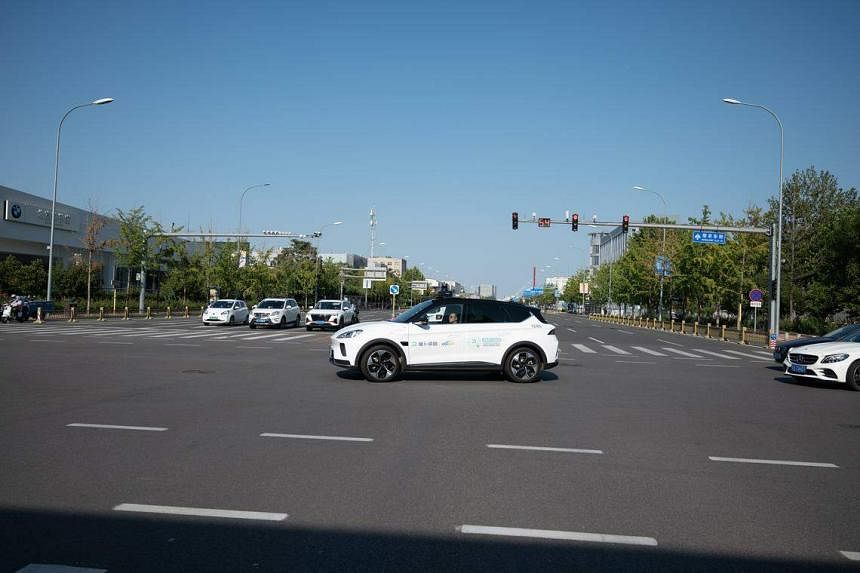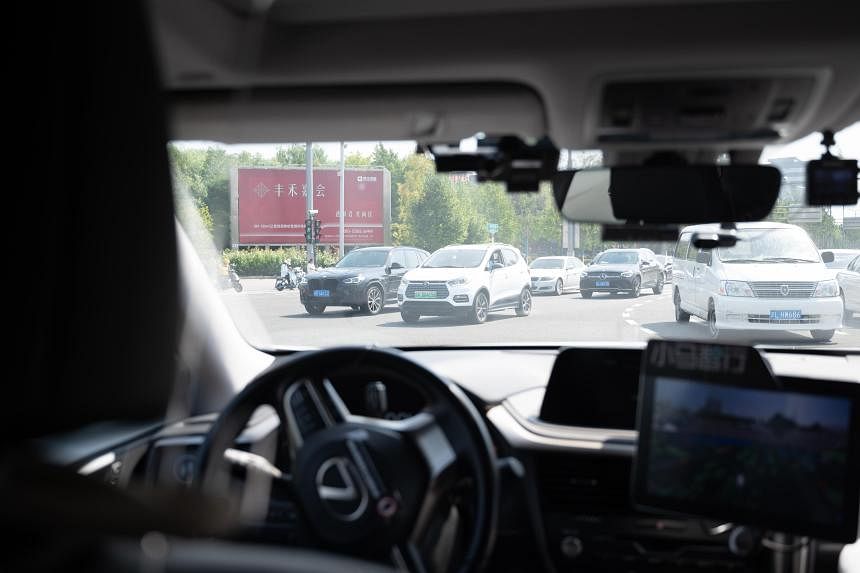BEIJING – Driverless taxis are no longer a curious sight for residents of the Beijing suburb of Yizhuang, where commercial operations are well under way, with dozens of “robocabs” clocking millions of kilometres.
They pick up passengers and drop them off at places such as shopping malls, offices and train stations, weaving in and out of lanes and navigating intersections without human intervention within a 60 sq km autonomous driving demonstration zone that was established in 2020.
Booking a ride is as straightforward as downloading an app and keying in ride information. Fares for these autonomous taxis are comparable with their human-driven counterparts. For instance, a 5km off-peak ride costs about 40 yuan (S$7.60).
In July, operators were allowed to charge fares for a fully driverless journey – sans an on-board safety supervisor to monitor the cab’s performance – in yet another milestone for the industry.
China has embraced assisted driving technology, with 42 per cent of new cars sold in the first six months of 2023 equipped with this technology – a 10 percentage point increase from the same period in 2022.
Since its first licences to road-test driverless vehicles were issued in 2018, the country has made steady progress in trials in major cities from Shanghai to Shenzhen, with few reported accidents so far.
While experts say the technology is not advanced enough for fully autonomous rides to handle all traffic scenarios, residents and operators believe increased ridership will pave the way for lower costs, greater reliability and public acceptance of such rides as a mode of transport.
One of the major operators, Pony.ai, has accumulated more than 25 million km of test mileage in areas such as Beijing, Shanghai, Guangzhou and Shenzhen.
Asked about the firm’s readiness for larger roll-outs, a spokeswoman said that with different road test scenarios and weather conditions in the various regions under its belt, the driving technology has matured over various iterations and can be quickly replicated and implemented in new regions and cities.
Based on its experience, autonomous driving fleet testing can be launched in a new city within a few weeks, she added.
Apollo Go, tech giant Baidu’s autonomous ride-hailing service, provided around 714,000 rides in the second quarter of 2023, up 149 per cent year on year.
In August, Baidu’s chief executive Robin Li said the expansion of Apollo Go’s testing area and the growth of its fleet have resulted in a rise in both daily orders and the percentage of fully driverless rides.
Professor Lee Der-Horng from Zhejiang University said that with driverless cabs still being a fairly new phenomenon, users will first need to have some understanding and familiarity with the technology involved.
But the tech scene in China is fairly competitive, and companies have launched different systems, which have had a “demonstrative effect”. These developments are necessary for the normalisation of commercial driverless taxis, said Prof Lee.
The maturity of the technology was apparent in the four rides this reporter took in Yizhuang, two of which had safety officers on board while the other two were completely driverless. Options vary among operators – for example, you can opt for a driverless car on Pony, while no such option is given on the WeRide app.
The cabs were able to speed up to cross intersections when the road was clear, and slowed down way in advance of traffic junctions.

But there was one instance where the safety officer on board had to honk to warn another car against cutting in from an adjoining lane. The honk was also sounded when a scooter approached the cab as it was about to make a turn.
Actual accidents have been reported elsewhere. In August, American operator Cruise had to halve the number of its driverless taxis after one of its vehicles collided with a fire truck in San Francisco.
But Mr Niels de Boer, chief operating officer of Nanyang Technological University’s Energy Research Institute, does not believe high-profile cases of accidents will affect overall consumer confidence.
There will always be some sceptics, others who embrace the technology, and a large group in between, he said. “I think shifts in perception relative to the public in general in either direction will only change when there is more data, visibility and personal experience with the technology.”
Ms Zhang, a visual designer who did not give her full name, said she has taken about eight driverless rides since first trying them out of curiosity, but stopped when the free and discounted rides ended about a year back.
She is optimistic that current safety concerns can be overcome when driverless technology matures. “Such development can also lead to improvements in other cases, such as self-driving public buses, and even for parcel and food delivery,” she said.


